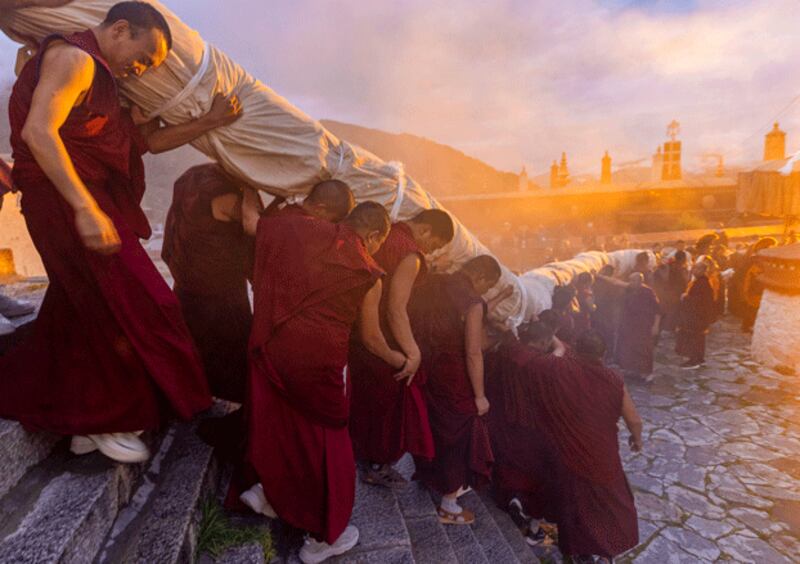Many people know Tibet — the vast, remote region that sits on the Tibetan Plateau — as the “roof of the world.” With an average elevation of about 14,800 feet to 16,000 feet, it is one of the highest inhabited places on Earth.
But what they may not know is that Tibetans and the Chinese have different ideas as to what constitutes “Tibet” due to a mixture of historical and geopolitical reasons.
And that means that many place names in the region today have both Tibetan and Chinese names.
What’s the difference between “Greater Tibet” and the Tibet Autonomous Region?
When Tibetans refer to Tibet, they mean “Greater Tibet,” a 2.5-million square-kilometer, or 970,000 square-mile, area covering much of the Tibetan Plateau and comprising the three historic regions of U-Tsang, Kham and Amdo.
They say this is the historic region of Tibet going back centuries.
Today, this makes up a vast chunk of territory about the size of Western Europe in southwestern China.

In 1965, the Chinese government — which annexed the region in 1950 — designated U-Tsang and the western part of Kham as the Tibet Autonomous Region, or TAR.
The TAR borders India, Nepal, and Bhutan to the south and spans more than 1.2 million square kilometers (460,000 square miles), making it China’s second-largest province-level division after the Xinjiang Uyghur Autonomous Region to the north.
RELATED STORIES
[ China replaces ‘Tibet’ with ‘Xizang’ in latest diplomatic documentsOpens in new window ]
[ Reject Tibet name change, leader of Tibet’s government-in-exile saysOpens in new window ]
Other parts of Kham and Amdo cover parts of the Chinese provinces of Qinghai, Gansu, Sichuan and Yunnan to the east of the TAR.
Half of the more than 6 million Tibetans live in the TAR, while the remainder live in the other four provinces.
How did the Tibet Autonomous Region come into being?
The Tibetan Empire emerged in the 7th century, and during its height in the 9th century, reached beyond the Tibetan Plateau and into parts of today’s Afghanistan, Pakistan, Kazakhstan, Kyrgyzstan, Tajikistan, India, Nepal, Bhutan, Myanmar, Bangladesh and China, including the Xinjiang Uyghur Autonomous Region.
Beijing, however, claims centuries-old sovereignty over Tibet based on the influence that Mongol and Manchu emperors exercised over the region in the 13th and 18th centuries.
But this view is disputed by exiled Tibetan communities, rights groups and some historians.
Following the Chinese Civil War (1945-1949), communist Chinese troops invaded Tibet and annexed it in 1950.
Beijing then signed a 17-point agreement — officially known as the “Agreement of the Central People's Government and the Local Government of Tibet on Measures for the Peaceful Liberation of Tibet” — with the government of the 14th Dalai Lama, Tibet’s spiritual and political leader.
The pact, which gave China sovereignty but granted the area autonomy, was legally repudiated by the Dalai Lama in March 1959 amid the Tibetan Uprising, a failed revolt against China’s rule.

That prompted the Dalai Lama to flee Tibet and go into exile in northern India, where he remains today in the small hill station of Dharamsala.
China formally established the TAR in 1965 to replace the Tibet Area, the former administrative division of the People’s Republic of China set up after the annexation.
Which names should be used for places in Tibet?
Tibetans have their own names for towns, counties and prefectures in Greater Tibet, while China has standard Mandarin names for them.
In late 2023, the Chinese government began using “Xizhang” — the Mandarin name for Tibet — as the region’s name in official English-language references, and has promoted its use outside China.
But Tibetan rights groups and experts say the move is a further effort by Beijing to erase Tibetan culture and to promote what it considers its legitimate occupation and rule there.
What is the U.S. position on Tibet?
The United States recognizes the TAR and Tibetan autonomous prefectures and counties in other provinces to be part of the People’s Republic of China.
But Washington has expressed alarm over China’s human rights abuses in Tibet and attempts to undermine and erase Tibetan culture and language.
Earlier this year, Congress passed — and President Joe Biden signed — the Resolve Tibet Act, which calls on Beijing to resume talks with the Dalai Lama or his representatives to arrive at a "negotiated agreement on Tibet."
Edited by Tenzin Pema for RFA Tibetan, and by Malcolm Foster and Kalden Lodoe.
